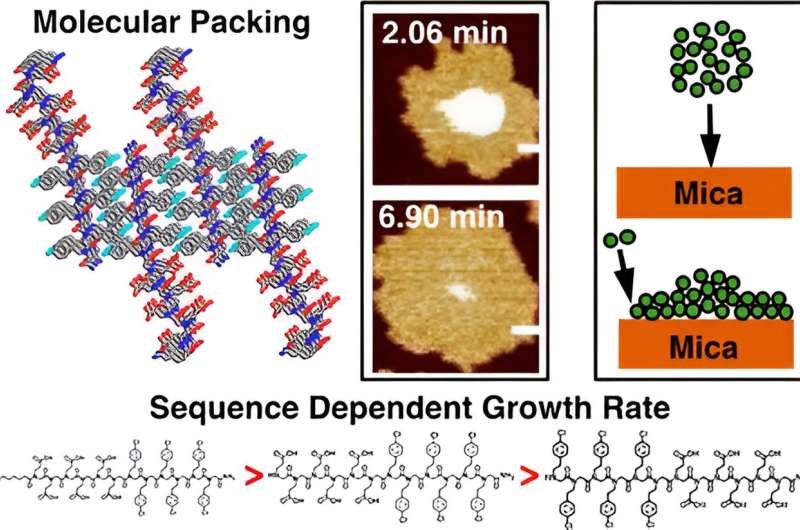This article has been reviewed according to Science X's editorial process and policies. Editors have highlighted the following attributes while ensuring the content's credibility:
fact-checked
peer-reviewed publication
trusted source
proofread
The influence of peptoid sequence on the mechanisms and kinetics of 2D assembly

Two-dimensional (2D) materials have unique physical and chemical properties and potential for a wide variety of applications. Peptoids, a type of molecule, compose a class of sequence-defined polymers that mimic biological compounds and can self-assemble into 2D crystalline sheets with unusual properties, such as high chemical stability and the ability to repair themselves.
A study, published in ACS Nano, examines the effect of peptoid sequences on the mechanisms and kinetics of their 2D assembly on mica surfaces and how molecular interactions alter assembly kinetics.
2D materials have strong potential for a variety of applications in fields such as chemical sensing, catalysis, energy storage, and biomedicine. Therefore, significant efforts have been devoted to investigate the mechanisms and kinetics of their formation to realize their full potential.
The findings of this study suggest that sequence details, the location of charged groups, and interactions with the underlying substrate significantly affect the thermodynamic stability and assembly kinetics of these materials.
Revealing the relationship between peptoid sequence and mechanisms of their assembly, as well as the resulting structures, helps close critical knowledge gaps and opens doors for future studies into co-assembly with functional components.
There is intense interest in controlling synthesis routes of 2D materials because of the breadth of potential applications they have in a wide variety of fields. 2D assemblies of peptoids, which have structures similar to those of peptides, are one such class of materials.
In this study, researchers investigated the effect of peptoid sequences on the mechanisms and kinetics of 2D assembly on mica surfaces using in situ atomic force microscopy and time-resolved X-ray scattering. They explored three distinct peptoid sequences that were amphiphilic, have hydrophobic and hydrophilic blocks, and can self-assemble into 2D sheets.
The study demonstrated that the assembly of these peptoid sequences on mica begins with aggregates being deposited and spreading into islands, crystallizing via well-known processes.
Results also demonstrated distinct characteristics of each peptoid sequence, as well as the significant differences that arise from interactions with the surface—the sequence that assembles most slowly in bulk solution and is the most soluble grows most rapidly on the mica surface and becomes the least soluble, exhibiting almost no detachment, meaning that once a growth unit attaches to the island edge, it is very unlikely to detach.
Overall, this study's findings indicate that sequence details, especially the location of charged groups, and interactions with the substrate can significantly alter thermodynamic stability and 2D assembly kinetics.
More information: Sakshi Yadav Schmid et al, Influence of Peptoid Sequence on the Mechanisms and Kinetics of 2D Assembly, ACS Nano (2024). DOI: 10.1021/acsnano.3c10810
Journal information: ACS Nano
Provided by Pacific Northwest National Laboratory





















